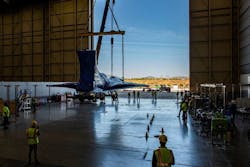X-59: NASA's quest to build a 'quiet' supersonic plane
PALMDALE, Calif., - If you've heard a sonic boom recently, you probably remember it. The loud, explosion-like bang -- caused by a plane flying faster than the speed of sound -- can be startling, and even crack windows, Jacopo Prisco reports for CNN. Continue reading original article.
The Military & Aerospace Electronics take:
27 July 2022 - The X-59 is shaped to reduce the loudness of a sonic boom reaching the ground to that of a gentle thump, if it is heard at all. It will be flown above select U.S. communities to generate data from sensors and people on the ground in order to gauge public perception. That data will help regulators establish new rules to enable commercial supersonic air travel over land.
Construction of the X-59, under a $247.5 million cost-plus-incentive-fee contract, is continuing at Lockheed Martin Aeronautics Company’s Skunk Works factory in Palmdale, California.
NASA is working closely with Lockheed Martin to create a large database of computational fluid dynamics simulations to verify the aircraft’s supersonic performance. The database includes simulations for all possible combinations of settings that a pilot uses to control the aircraft and the flight conditions that may be encountered. This database is crucial for supplying data for a flight-planning tool that is being used to assist and teach pilots how to fly the X-59, before it even flies.
Related: NASA's experimental X-59 supersonic jet could be built by the end of 2020
Related: Ames' contributions to the X-59 quiet supersonic technology aircraft
Related: A view of NASA’s X-59 engine inlet
Jamie Whitney, Associate Editor
Intelligent Aerospace
